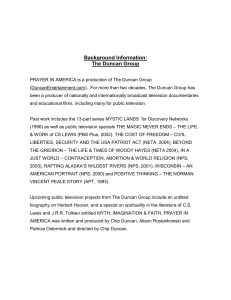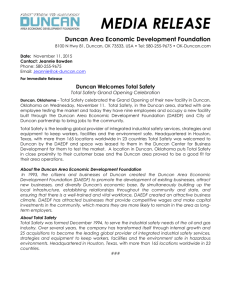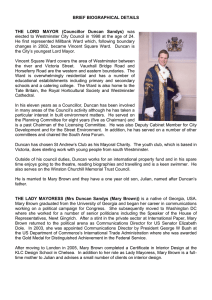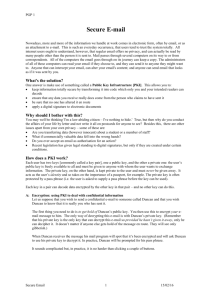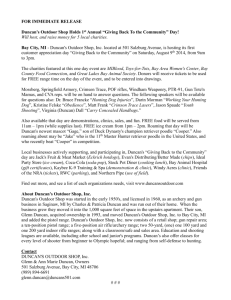Robyn Pope, Wesley Community Action
advertisement
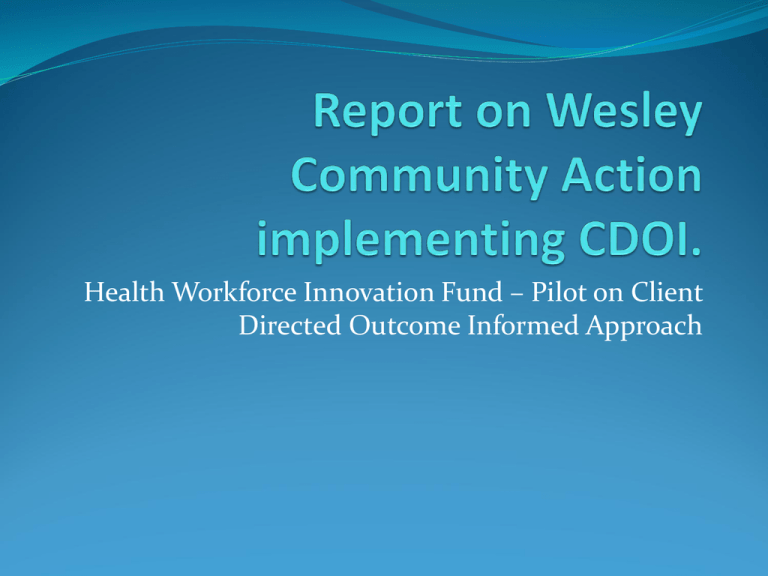
Health Workforce Innovation Fund – Pilot on Client Directed Outcome Informed Approach Outline What preconditions support a client directed approach – the journey of Wesley Community Action What is CDOI and its research base The Health Workforce Innovation Fund Pilot research, method and findings Preconditions for Client Directed Approach - Wesley Community Action’s Journey St Lukes training – 2002 Intentional strength based practice – 2003 Leadership – confirming SB approach SB conference 2007 Palmerston North – presentation Dr Barry Duncan Wesley Way 2011 – organisation practice framework. What is CDOI? Client Directed Outcome Informed is an interaction where; the client’s voice is privileged recovery is expected and the worker purposefully forms a relationship based on their client’s theory of change. It is the only consumer rated outcome tool that is empirically validated. The research base – Treatment Depression Collaborative Research Project Considered to be the most sophisticated comparative clinical trial ever conducted Four approaches (CBT, IPT, Drug, Placebo) No difference in outcome between approaches. The client’s rating of the alliance at the second session, the best predictor of outcome across conditions. Elkin, I. Et al. (1989). The NIMH TDCRP: General effectiveness of treatments. Archives of General Psychiatry, 46, 971-82. Evidence based practice and Practice based evidence. 9 randomised clinical trials show the effect of feedback It is the single most important thing you can do differently Factors accounting for successful outcomeMichael Lambert Common Factors Relationship Spontaneous Remission Client/Extratheraputic Placebo/Hope/Expectancy Models/Techniques International Research Length of stay in psychotherapy was reduced by 40 percent to 50 percent across a broad range of behavioral health services (Bohanske & Franczak, 2010; Duncan, Miller, Wampold, & Hubble, 2010; Miller, Duncan, Sorrell, & Brown, 2005). Cancellation rates declined by 40 percent and no-shows by 25 percent (Bohankse & Franczak, 2010; Duncan, Miller, Wampold, & Hubble, 2010) . Child & Family Services in South Florida. Based on 2100 cases during a recent 2-year period CFS reported a decrease in the average number of sessions by 40%, dropouts decreased by 40%; no-shows decreased by 50%; cost savings estimated at $494,600.00. (Dave Claud, this listserve. Norway Study – Couple Therapy Key Finding - Feedback v Treatment As Usual; Over doubled effectiveness; Effect Size: 0.5; 4 times # of clients reached clinically sig. change Anker, M., Duncan, B., & Sparks, J. (2009). Using client feedback to improve couple therapy outcomes: A randomized clinical trial in a naturalistic setting. Journal of Consulting and Clinical Psychology, 77, 693-704. HWIF - Methodology • Dr Barry Duncan completed 2 day training for staff within: • Wesleyhaven (residential aged care) • Counselling service • Youth services • Older People Community Services • Drug and Alcohol Services • Independent Evaluator interviewed staff before training and after the pilot and 8 months post training • Focus on how CDOI contributes to; staff retention, access to additional training, and staff satisfaction. HWIF Pilot - Findings “In the end of project survey, 74% of respondents agreed that CDOI enhanced their practice. Examples of this described in interviews centred on using all of the time available on clients’ concerns, getting to issues that had previously been missed, and accountability.” “By the end of the project 91% of staff surveyed thought that using the CDOI tools had benefits for clients” Quotes from Staff in Findings “[The tools] hold us really accountable, when there is a change in the ratings, it holds us accountable for following things up – which is important – to do what you say you will. “ “It has added to my satisfaction with work in a way, made me more aware of residents’ individual needs – just by talking and sharing you can find out [things] that are beneficial for residents. It does make a difference – people open up and give us a better understanding.” Quotes from Staff in findings “Using CDOI does get older people to concede that forward movement is possible.” “It has led to better use of the time. Before we use to talk about everything under the sun, now straight away we are onto the client, their issues, and we get to issues I’d missed, the conversation we have brings it out, all the issues for clients.” “Residents do want to please you, but when you sit one to one and focus on things relevant to them, that's when they start to share (their real concerns).” Evidenced based practice – WCA has found out WATCH Programme: Number of Tauira attending three or less appointments reduced from 58% to 15% Counselling Service Number of no Shows reduced from an average of 14 per month to 5 per month WCA Tauira Speak Further information On CDOI – www.heartandsoulofchange.com On CDOI - New Zealand focus www.wesleyca.org.nz HWIF pilot report – www.healthworkforce.govt.nz and www.wesleyca.org.nz

